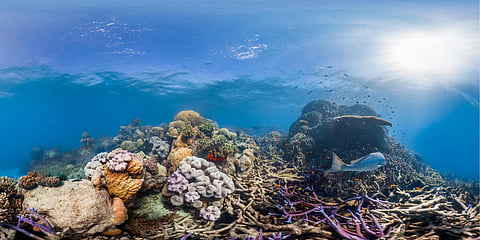“Close to 75% world’s coral reefs exposed to bleaching-level heat stress in last 17 months”
The story has been changed to mention that almost 75 per cent of the world's coral reefs were exposed to bleaching-level heat stress in last 17 months. Previously it erroneosly read "Close to 75 per cent of the world's coral reefs bleached in last 17 months".
Almost three-fourths, or 72.1 per cent, of the world’s coral reefs have experienced bleaching-level heat stress, the highest recorded to date, NOAA said.
Since January 2023, almost three-fourths of the world’s coral reefs have been affected on a spatial scale and possibly more, said Derek Manzello, coordinator of NOAA Coral Reef Watch.
In an interview with DTE, he said, “We still need the in-water coral data to really know what the impacts are. I'm slightly hesitant to say that this is the worst event on record because the last one lasted for three years, and for this one, we're in year two. It's my hope that if the heat stress goes away quickly, in the next several months, that maybe the impacts won't be as severe as they were over the three years.”
The last severe coral bleaching, lasting from 2014 to 2017, impacted 65.7 per cent of the coral reefs. However, Manzello noted that some corals take a year or two before the actual impacts are seen. The world is experiencing the fourth global coral mass bleaching on record since 1998.
Manzello highlighted that apart from the spatial scale, the magnitude of the current bleaching has also been severe. He mentioned that the north and southern Atlantic Ocean, stretching farther towards the Caribbean and Florida, saw record-setting heat stress in the summer of 2023. “It was two to three times greater than ever occurred before on record in the satellite record,” he said.
Mass mortality events have been recorded among reef-building species such as Elkhorn and staghorn in Florida, Puerto Rico, Mexico, and Brazil. A similar situation has been reported from the Great Barrier Reef, which has not experienced severe bleaching since 2022. In the Indian Ocean, coral reefs have been affected in Seychelles, Madagascar, Kenya, Tanzania, Maldives, India, Thailand, Malaysia, Indonesia, and the Chagos Archipelago, among other places.
He said scientists are documenting these events and mass mortality, and it could take another year to know the actual scale of the impact.
He explained that corals respond to elevated temperatures and the duration of exposure to extreme heat stress. For instance, in Florida, the magnitude of heat stress was two to three times higher, and the bleaching started a month earlier than usual.
Manzello said that given the impacts of climate change resulting in frequent stops and bleaching events, it may become challenging for corals to recover in the long term.
“The big issue is when you start having mass mortalities of corals, these reefs will start shifting to a net erosional state. And what that means is, they start losing all that architectural complexity that you see on a healthy reef with all those branching corals and everything. Basically, the reef becomes flattened over time, which is detrimental.”
He added that reefs experiencing mass mortality require larvae and baby corals coming in from water columns from other parts of the ocean to regenerate. It may take about five to seven years for corals to show signs of recovery, and they are vulnerable to diseases during this phase. Full recovery can take about 15-20 years, depending on their location.
Corals are crucial to marine ecosystems as they are the rainforests of the sea. They provide habitat and food to 25 per cent of marine species globally. Mass mortality means these species lose their habitat and dependency on the corals, he explained.
Manzello noted that corals are also important for many species that have not been documented to date and are equally crucial for humans. He mentioned that some experimental cancer drugs are derived from compounds found in coral reefs.
“Hypothetically, there could be cures for all kinds of human diseases that we can source from coral reef organisms we don't even know exist. It's unfortunate that we're likely going to lose species that will never even be documented on coral reefs.”
Regarding coral reef restoration exercises carried out across various parts of the globe, Manzello said the coral reef management science community’s worst fear is that, given climate change, in the next 20-30 years, coral reefs may not recover due to high stress.
“We at NOAA, the Australian Institute of Marine Sciences, the University of Hawaii, the University of Miami, and others are engaged in the process of assisted evolution, where we are trying to find corals that have higher heat tolerance than others.”
Manzello said the attempt is to identify those genes and successfully breed corals for the future that are more tolerant. “This has been successfully done in multiple locations now. There could be more outliers who have the natural ability to adapt and evolve as well.”
However, he pointed out that the big issue is the scale of the problem. “For example, the Great Barrier Reef is bigger than the country of Italy. Any kind of restoration or intervention activities that take place are going to be very localised in scale.”
Manzello urged that it is climate change that needs to be addressed for a problem of this magnitude.


